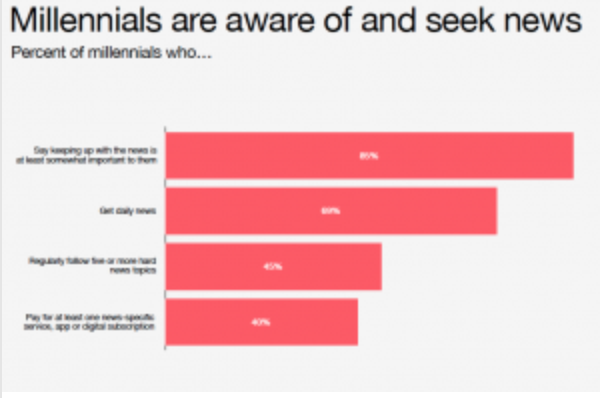
Proof that Millennials Crave News
This piece is produced by CNN Newsource as part of our ongoing conversations on news industry developments and opportunities with our partners in local news.
Appealing to millennials is key to the long-term success of news organizations. They outnumber baby boomers already, and their influence will only grow in the years to come. This post will go over data compiled by CNN for its 2017 POV on modern news consumption. The full paper is available here.
It is something of a tradition to question whether millennials really care about news. But CNN’s experience as the top-rated news brand with millennials suggests that millennials do care about news. They simply consume it differently than previous generations. This is borne out by the data.
A strong majority of millennials surveyed, 85 percent, say keeping up with the news is at least somewhat important to them. Nearly 70 percent get news on a daily basis. Just under half are in the habit of following at least five hard news topics at once, and 40 percent pay for at least one news-specific service, app, or digital subscription.
For local news, the implication is clear: millennials are an audience that cares about news and will consume it in the right circumstances. But while they share with baby boomers an interest in the news, their media consumption habits contrast sharply with their predecessors.
One key point of difference is where millennials consume media. Millennials watch half as much live TV as the average adult, but they are by far the largest consumers of video via smartphone. Of all the demographic groups, they are most likely to get their news through social media and least likely to get it from TV.
Surprisingly, despite this preference for consumption via social media, millennials are no more likely than older cohorts to publicly share the news they consume on social networks. In fact, both the 30-49 and 50-64 age brackets are more likely than millennials to share or repost news stories on public or semi-public social media networks.
But news organizations should note that this does not mean that millennials are sharing less content than other age groups.
Public social networks don’t capture all online referrals. Data from link management platform Bitly suggests that so-called “dark social”—that is, one-on-one sharing not seen by broader social peers or tracked by websites—accounts for up to 70 percent of online referrals. Prominent “dark social” sharing methods include email, messaging services like WhatsApp and Facebook Messenger, and native mobile apps like Snapchat.
In the next post, we’ll take an in-depth look at what platforms millennials are using to find and share news content. In the meantime, we invite you to view the full whitepaper, “Capturing the Modern News Consumer.”
###
Since 1987, CNN Newsource has been the most widely-distributed news services in the business. Visit cnn.com/newsource to learn more about the services and expertise we provide to help our affiliates tell their stories.


